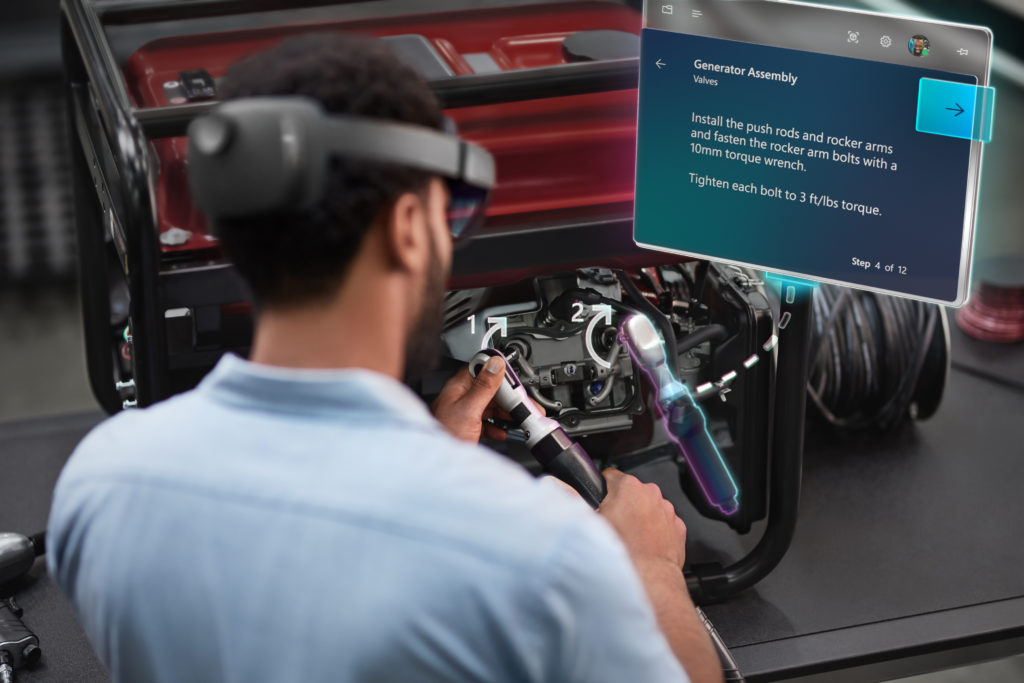 February 24, 2019 – In addition to the announcement of the HoloLens 2 today at MWC in Barcelona, Microsoft also announced the Azure Kinect Developer Kit (DK), Dynamic 365 Guides, and two new Azure mixed reality services that are designed to help developers and businesses build cross-platform, contextual and enterprise-grade mixed reality applications.
February 24, 2019 – In addition to the announcement of the HoloLens 2 today at MWC in Barcelona, Microsoft also announced the Azure Kinect Developer Kit (DK), Dynamic 365 Guides, and two new Azure mixed reality services that are designed to help developers and businesses build cross-platform, contextual and enterprise-grade mixed reality applications.
The Azure Kinect DK is a developer kit that combines AI sensors in a single device. At its core is the time-of-flight depth sensor Microsoft has developed for HoloLens 2, a high-def RGB camera and a 7-microphone circular array that will enable development of advanced computer vision and speech solutions with Azure. Initially available in the US and China, the Azure Kinect DK is available for pre-order for USD $399.
Dynamics 365 Guides is a new mixed reality app that allows employees to learn by doing. Guides enhances learning with step-by-step instructions that guide employees to the tools and parts they need and how to use them in real work situations. In addition to the experience of using Guides on HoloLens, a Guides PC app allows users to create interactive content, attach photos and videos, import 3D models and customize training in order to build a repeatable learning tool.
Microsoft expects its Guides application to help minimize downtime and increase efficiency for mission-critical equipment and processes. It is also the third Dynamics 365 application that will work on both the previous generation of HoloLens and the new HoloLens 2. Dynamics 365 Guides is available in preview starting today.
The first of the new Azure MR services is ‘Azure Spatial Anchors’, which enables businesses and developers to create mixed reality apps that map, designate and recall precise points of interest that are accessible across HoloLens, iOS and Android devices. These precise points of interest enable a range of scenarios, from shared mixed reality experiences to wayfinding across connected places.
The second service announced was ‘Azure Remote Rendering’, which renders high-quality 3D content in the cloud and streams it to edge devices in real time, whilst keeping details intact.
Microsoft stated that this will help users experience 3D “without compromise” and will help enable “better, faster decisions”, as it aims to avoid the process of simplifying 3D assets by rendering in the cloud instead.
Azure Spatial Anchors is in public preview as of today. Azure Remote Rendering is now in private preview in advance of its public preview.
Furthermore, Microsoft also commented on its HoloLens Customization Program. With HoloLens 2, the company is introducing this program to enable customers and partners to customize HoloLens 2 to fit their environmental needs.
As HoloLens is used in a variety of different settings, from construction sites and operating rooms to the International Space Station, the headset has had to pass basic impact tests from several protective eyewear standards used in North America and Europe. It has been tested and found to conform to the basic impact protection requirements of ANSI Z87.1, CSA Z94.3 and EN 166.
The first company to take advantage of the HoloLens Customization Program is one of Microsoft’s long-standing HoloLens partners, Trimble.
Today, Trimble announced the Trimble XR10 with Microsoft HoloLens 2, a new wearable hard hat device that enables workers in safety-controlled environments to access holographic information on the worksite.
Image credit: Microsoft
About the author
Sam is the Founder and Managing Editor of Auganix. With a background in research and report writing, he has been covering XR industry news for the past seven years.
